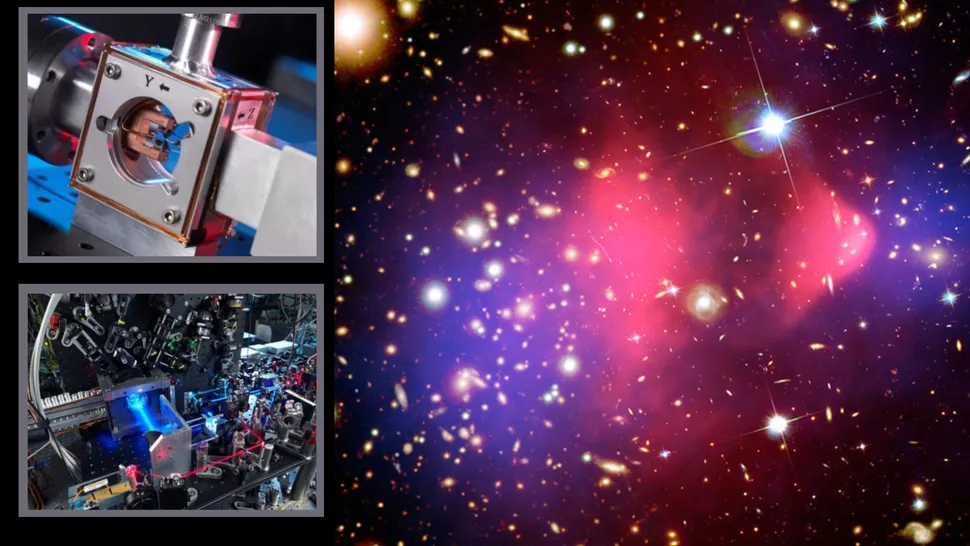Scientists are using the atomic clock to probe some of the universe’s greatest mysteries in the lab, including the nature of dark matter. They say they brought cosmology and astrophysics “to Earth” in the process. The project, the result of a collaboration between the University of Sussex and the UK’s National Physical Laboratory (NPL), uses the tick-tock of these incredibly sensitive clocks to hunt down hitherto unknown ultralight particles.
These particles may be related to dark matter, a mysterious substance that makes up about 85% of all matter in the universe but remains almost invisible to us because it doesn’t interact with light or, more specifically, electromagnetic radiation. Scientists believe that most galaxies are surrounded by a cloud of dark matter, but its existence can only be inferred from its effect on gravity.
“Our universe as we know it is governed by the laws of physics, so gravity is governed by general relativity and particle physics by the Standard Model of particle physics,” said project leader and professor of physics at the University of Sussex, Xavier Calmet. space.com. “We refer to deviations from these laws as ‘collapse in physics,’ which is essentially synonymous with new physics that goes beyond our current understanding of the universe.”
This new physics could be used to explain the nature of dark matter that doesn’t fit the standard model.
“One of the biggest mysteries is the nature of dark matter. We know it exists, we see its effects on our universe, but we don’t have a valid explanation under the Standard Model of particle physics,” Calmette continued. “There has to be new physics, but we don’t know how to identify these new particles and how to connect them to ordinary matter.”
How can “new physics” be observed with atomic clocks?
According to the established laws of physics the clock should run at a constant speed, but physics outside the standard model will result in very small charges at atomic energy levels. This will affect the tick-tock rate of clocks, but the change will be so small that it can only be detected by an incredibly accurate clock, and that’s where atomic clocks come into play.
Also read – SpaceX launches 22 Starlink satellites into orbit
“Atomic clocks bring cosmology and astrophysics to Earth, enabling the search for ultralight particles that could explain dark matter in the lab,” said Calmet.
The atomic clock measures time using atoms with two potential energy states. When atoms absorb energy, they go into a higher energy state. They then eventually release this energy and return to their lower ground state.
In atomic clocks, groups of atoms are prepared by forcing them into a higher energy state with microwave energy, and the characteristic and consistent speeds (resonance frequencies) at which they vibrate between states are used to accurately measure time.
So, for example, all cesium atoms resonate at the same frequency, so the standard measure of a second can be defined as 9,192,631,770 cesium cycles. This cycle per second makes the atomic clock incredibly accurate, as it happens with much less change than, for example, the swing of a pendulum.
“It has recently become clear that dark matter can consist of ultralight particles that interact very weakly with ordinary matter,” Calmet said. he explained. “If that’s the case, dark matter will actually behave like a classical wave interacting with electrons and protons. This dark matter wave will give these particles small shocks.”
Calmet added that these effects of ultralight dark matter particles on the building blocks of the atom will cause fundamental constants of the universe, such as the fine structure constant, or “alpha”, a measure of how strongly the particles are bonded together, to change over time. due to the electromagnetic force and the mass of the proton.
“Because the atomic clock is an incredibly sensitive device, it can detect these shocks and therefore detect ultralight dark matter,” he continued. “By comparing two clocks, one sensitive to changes in alpha signal and the other less sensitive to changes in alpha signal, we can get a limit on the variation of this fundamental time constant and thus put a limit on ultralight particles.”
Also read – Do advanced civilizations know of our existence?
Calmet believes the technique could potentially be used to study another problematic aspect of the universe for physicists: dark energy, the unknown force that causes space to expand rapidly.
While Calmet concedes that dark energy is more likely to be explained by the cosmological constant (a type of energy that acts almost opposite to gravity, stretching the fabric of space and pushing galaxies apart), it’s unlikely that it could be related to dark energy. ultralight particle. In this context, future clocks may also be sensitive to this particle and its associated wave.
“While clocks did not discover new physics at this stage, we were able to develop a new theoretical framework for exploring general new physics with clocks, and within this approach we were able to derive constraints independent of the first model of physics beyond the standard model,” Calmet concluded. “We are creating a new field at the crossroads of atomic, molecular and optical physics and the traditional physics of elementary particles. These are exciting results!”.













